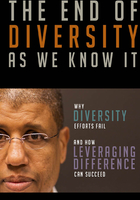
1
The End of Diversity
as We Know It
I met Aaron Evans when I was in Northern California conducting research at Silicon Valley high-tech firms. He struck me as a bright and thoughtful manager, and a genuinely nice guy. His peers had high regard for him, too, as I learned during my visit. As we talked about diversity and its role in his company, he was cordial and a little bit stiff—just his normal demeanor, I assumed. But as we talked, I sensed his increasing agitation. I asked if he was okay. He said he was fine, so we kept talking, but he still seemed uneasy. Finally I inquired, “Aaron, you really seem uncomfortable. Is everything okay?” He sat quietly for a moment and then replied, “To be honest, I know we’re supposed to spend this time talking with you about diversity, but I have a real problem with all this. I have an issue with this topic.”
From there, we had a long conversation about what was really on his mind. Aaron took great pains to tell me that he was not biased, sexist, racist, or any other such label. Rather, he had a problem with diversity in his company because in the fifteen years he had been a manager there, he had seen diversity efforts do more harm than good. He had felt pressure to hire so-called “diverse” people (code for women and people of color)—who weren’t easy to find—when he already had great candidates in his own pipeline who happened to be white males. And then the diverse hires often left the company within two years—or worse, they stayed but just couldn’t do the job. Promotion decisions in favor of women and minorities seemed unfair, since people were often pushed forward before they were really ready. He had attended more than a few diversity training programs, but they had had little impact on his day-to-day work. Even worse, the real diversity that mattered to him—how to manage people of diverse styles of thought and work habits—didn’t seem to count in the company’s definition of diversity.
Eileen Vargas had been working at the same Silicon Valley firm as Aaron Evans for eighteen months. We spoke for a while, and I was struck by her professional, no-nonsense style. She was clearly very smart, both with regard to her particular area of expertise and with regard to the firm’s social and political machinations. The more we spoke, the more she seemed to relax, and we began to really talk about her experience there. She described how difficult it had been for her, as a Latina, to fit in. She was clear about the structural impediments: she was only the third female to be hired in her department of thirty-three employees, and the only person of color.
As a seasoned manager, she had known she might have to deal with both unintended and deliberate bias. And she had known she would need to “influence gently” in order to win over skeptical colleagues who would quietly question her credibility when she advocated for cutting-edge ideas. This was all familiar terrain for Eileen.
But she kept feeling that it should be better than this. She had come here because her research had shown that this firm was an industry leader, with senior management who understood the importance of investing in people as a way of creating value. She knew that the CEO had a particular passion for diversity, and she thought that boded well. And even though her department was thin on diversity, in recent years the company as a whole had made great strides in its hiring and promotion of women and people of color.
And she was miserable.
She said to me, “Look, I’m not naive. I know that places like this are almost always difficult for people like me. But it shouldn’t be like this. I’m talented and I want to contribute to this company, and there must be a way for me to do that and be properly rewarded for what I offer. I want to work well with my peers and to be a part of this place. I see lots of my colleagues enjoying their work and one another, and I want that, too.”